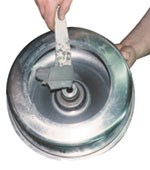Spinning Away Waste
Chemical and mechanical processing work together to treat the vibratory finishing wastewater at Aro-Sac, increasing production,making the water reusable and rendering the sludge a non-hazardous waste...
Since A. Robert Saccoccio founded Aro-Sac, Inc. (N. Providence, RI) three generations ago, the company has been a leading manufacturer of earring clips and other components for the jewelry industry. And, it continues to this day, providing the jewelry industry with high quality products and the newest and most innovative designs.
The manufacturing process consists of traditional stamping and forming of various metals, such as brass, copper and sterling silver. However, once the pieces are formed, they must be polished inside and out and burrs removed. This is accomplished using vibratory finishing, which also carries with it its own particular waste treatment provisions.
As with any vibratory application, a slow, continuous stream of water is fed into the bowls for lubrication of the parts and finishing media. The water discharged from the vibratory bowl contains metal fragments and degraded media that require disposal. Flushing the water down the sewer was not an option for Aro-Sac due to the metal content of the effluent, not to mention the possibility of clogged pipes due to the ceramic and plastic media fines. Until recently, the company evaporated the used water, which was time consuming and rather expensive, and then collected the residual sediment for proper disposal.
The inefficiencies of the process became apparent to Bob Montaquilla, president, and Dave Ruggiero, Jr., plant manager. Water use was high, evaporation was taking too much time and costing more than they liked. Also, sediment disposal was not only expensive, but it had to be accompanied by complicated paperwork.
Messrs. Montaquilla and Ruggiero investigated methods for cleaning the used vibratory water and chose to install the Centech 3100, a filterless filtration system from Barrett Centrifugals. The system consists of a capture tank, centrifuge and 250-gal holding tank. The water contaminated from jewelry finishing drains from the vibratory bowls into the capture tank. From there, it is pumped into the centrifuge where it is spun at 2,100 times the force of gravity. This forces the metals and abrasives to separate from the water and collect in the centrifuge's bowl. The clean water flows by gravity to the 250-gal holding tank, which backfeeds to the capture tank, to be fed again through the centrifuge. This recirculation loop, together with the high gravitational forces generated by the centrifuge, removes solids as small as 2 microns while maintaining a low level of contamination in the water.
The centrifuge increased the life of the vibratory system's water 12-fold. The water, which was normally evaporated weekly, could now be evaporated once every three months. Also, the water that was recirculated back to the vibratory bowls daily had a consistently low solids content. The ability to efficiently and cost effectively deal with his vibratory effluent allowed Mr. Montaquilla to expand his business by offering his vibratory services and expertise on a contract basis.
However, Mr. Montaquilla's life was about to become even easier. During a visit from Bel Air Finishing, the company's media supplier, Mr. Montaquilla was introduced to Aqua Safe, a quick, economical, easy-to-use dry treatment that encapsulates metals, oil and other contaminants from aqueous streams. The product causes chemical and physical reactions that encapsulate contaminants, developing a floc that sinks to the bottom of the holding vessel. Frequency of treatment varies depending on the type of metal finished and system used.
The water is agitated for several minutes, after which the flocking process starts. This encapsulates the suspended contaminants, even submicron particles and emulsified oils, causing them to settle to the tank bottom. The treated liquid is then pumped through the centrifugal system to remove the encapsulated material.
The combination of the mechanical centrifuge and the chemical flocculent provides water so clean that Aro-Sac has used its water for six months without evaporating or replacing it. Because the encapsulation process is so thorough, the company has been able to send the flocked sludge to landfill as a non-hazardous material.
"I have the best of both worlds," said Mr. Montaquilla. "The centrifuge maintains a low solids content in my water on a daily basis, and the encapsulation process allows me to essentially start with new water after each treatment. The techniques make sense on their own and even more sense together. The combination has been a real time and money saver."
Related Content
Reduced, Reused and Recycled Powder Coatings Are the Future
They say necessity is the mother of invention, and with millions of pounds of powder coating going into landfills a year, these two companies have found novel approaches to dealing with this waste stream.
Read MoreSustainability, Electrification and Mobility
Industry events like ECOAT are good indicators of the trends that are top of mind for those in manufacturing.
Read MoreAlgae-Based Coating Enables Modular Carbon Capture Removal System
Reactive Surfaces, an innovator in bio-based coatings, works on development of Carbon Capture Coatings, which harness the natural CO2-capturing capabilities of live algae.
Read MoreSolar-Powered Photonic Cooling Enables Energy-Saving Coating
Passive cooling technology can reduce interior temperatures 5-13°C, offering weight, cost and CO2 benefits for cars, construction, aircraft and more.
Read MoreRead Next
Delivering Increased Benefits to Greenhouse Films
Baystar's Borstar technology is helping customers deliver better, more reliable production methods to greenhouse agriculture.
Read MoreA ‘Clean’ Agenda Offers Unique Presentations in Chicago
The 2024 Parts Cleaning Conference, co-located with the International Manufacturing Technology Show, includes presentations by several speakers who are new to the conference and topics that have not been covered in past editions of this event.
Read MoreEpisode 45: An Interview with Chandler Mancuso, MacDermid Envio Solutions
Chandler Mancuso, technical director with MacDermid Envio discusses updating your wastewater treatment system and implementing materials recycling solutions to increase efficiencies, control costs and reduce environmental impact.
Read More



























